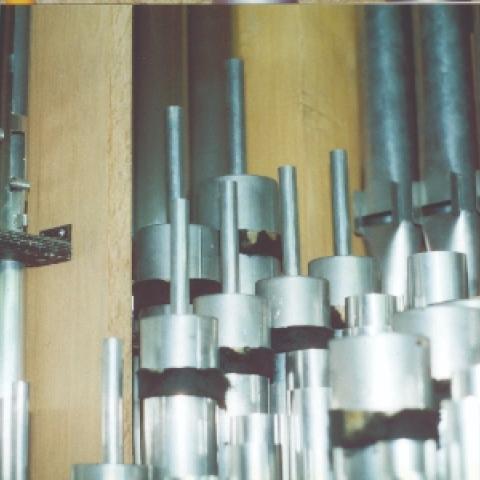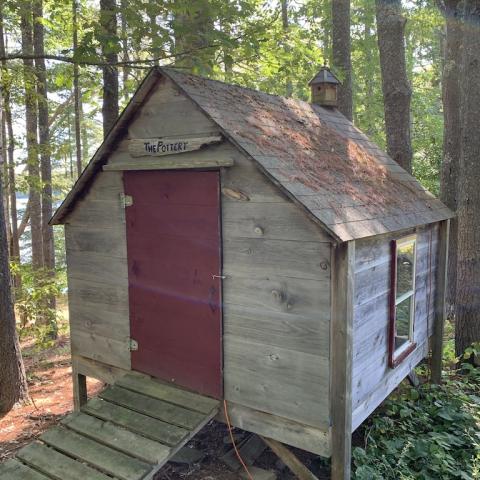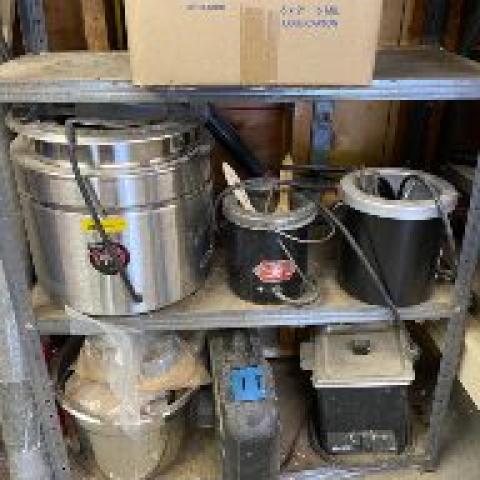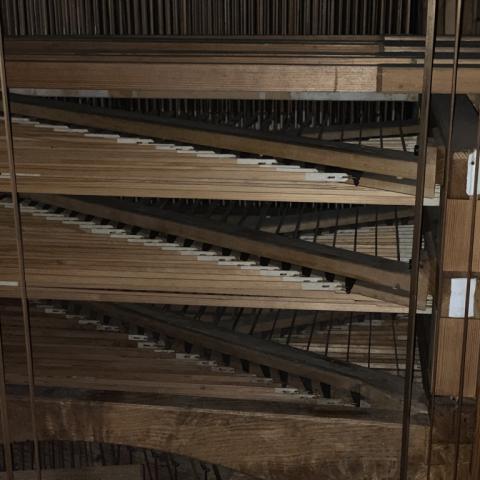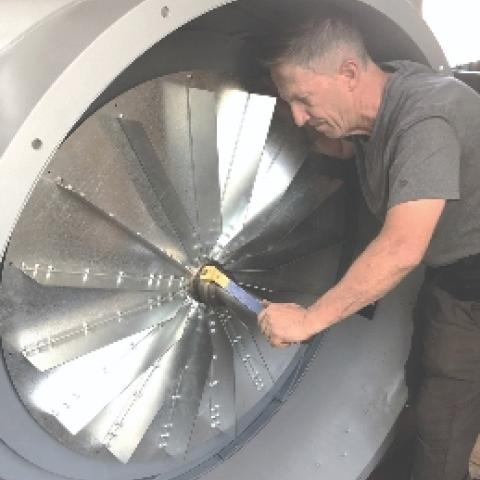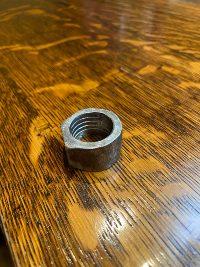
Mechanical failure
This morning while doing errands with Wendy, I noticed a lug nut on the tarmac next to our parked car. The inside thread was stripped bare, even shiny and smooth, and while the outside should have had six corners and six sides, only three corners and two of the sides were intact while the rest was rounded. I put it in my pocket and worried it with my fingers as we completed our errands and placed it on my desk when I got home. I have been glancing at it and handling it, wondering how it got so badly deformed. Was it cross-threaded onto the lug so aggressively that the thread was compromised? Did it fall off a car parked there? If so, how many other lug nuts were in such bad shape? How did the outside of the nut get rounded? Did other lug nuts on the same wheel suffer the same damage? It’s bad when a wheel falls off.
Take care of your machines.
For most of us, our cars are the most complex and sophisticated machines we own, and there are some simple maintenance procedures we follow to ensure smooth operation. The fact is that failure to take these steps can lead to serious damage and mortal danger. We change the oil every few thousand miles. When the engine is not running, the oil sits in a reservoir at the bottom of the engine known as the oil pan. When you start the engine, the oil pump brings oil to the top where it splashes about the camshaft and valves, and trickles down across myriad parts to be recirculated. If the oil gets dirty, it does not lubricate as well. If the oil runs dry, the engine parts heat to the point of welding themselves together. I once hit a rock with a lawnmower that cracked the oil drain plug inside the mower deck. The oil ran out, and the engine seized with a bang.
Did you ever notice how your car’s engine clatters for a few seconds when you start it on a cold morning? That is because the oil is extra thick and takes a moment to get to the top of the engine. Are you one of those drivers who starts the engine and immediately puts the car in gear? It would be better to wait until the oil gets to the top of the engine and the clattering stops before you put a load on the engine.
You are backing out of a parking space. You check your mirrors, shift into reverse, and start the car moving. When you shift into drive you hear a clunk from under the floor. Each of those clunks means a little extra wear on the transmission with its hundreds of precise interior fluid channels. I back out of the space, shift into neutral as I stop the car, then shift into drive before I start moving again. No clunk. It is an extra step, but I think it means my transmission will last longer. It is as easy to develop that habit as putting only one space after a period.
When my sons were young, they were delighted to find that they could cause the plumbing to make banging noises in the walls when they turned a bathroom faucet on and off at my parents’ house. My older son is now an expert fabricator with high-end welding skills, and we laughed together recently over that memory. They could have done serious damage to the house by breaking soldered plumbing joints inside the walls.
The same son was a wild driver early on. He loved going fast, he loved having smoke coming off his tires, and he pushed a series of cars to early ends, adding to the huge expense of many speeding tickets, cancelled insurance policies, and suspended licenses. When he finally broke those habits, he observed that it is lot less expensive to drive more conservatively.
Try it again without making noise.
The pipe organ is a musical wonder, and no other musical instrument has such complicated mechanical systems. Our habits at the keyboard and our attitudes toward our instruments can have a significant effect on their reliability. I do not need to mention the organist who habitually placed a sugary cup of coffee on top of the console stopjamb. I chided him about the ugly rings on the lovely, shellacked surface and warned about spills. The spill happened late on a Saturday night, and I was able to get the organ working a little before Sunday services, but removing the keyboards, replacing felt bushings, cleaning contacts, and regluing several of the sharp keys cost many thousands of dollars.
I do not need to mention the organist who played on a nineteenth-century mechanical-action organ and caused heavy bangs in the stop action because of the force he used on the drawknobs. The travel of those sliders is regulated and limited by little steel pins drilled and driven into the windchest tables. There are slots in the sliders that ensure the correct amount of motion, and the pins also fit into holes in the bottom of the toeboards, assuring that they are in the correct position. Slam, bang, thud hundreds of times every time he played, and the stops gradually grew softer and out of tune. Those guide pins were being driven out of their holes, and the sliders were traveling too far, going past the “full open” position, constricting the holes, and underwinding the pipes. That one was a $45,000 repair, removing all the pipes, lifting the toeboards and sliders, repairing the holes, redrilling the pins, then putting everything back together and tuning the pipes.
And I do not need to mention the organist who complained that the piston buttons were unreliable, demonstrating them to me with furious jabs from a powerful finger. Maybe, just maybe, the tiny contacts and springs that make those buttons work were prematurely worn by that vigorous action.
Just as I try to avoid that extra clunk when shifting my car from reverse to drive, you might listen to your console as you play. Does your technique cause extra noise at the keyboards? You might be causing excessive wear.
When I was a student at Oberlin, I had an important lesson about unnecessary noise. My organ teacher, Haskell Thomson, organized a winter term project for a group of us to be led by Inda Howland, the legendary teacher of eurhythmics and disciple of Émile Jacques-Dalcroze. For three days a week through the month of January, ten or fifteen of us bounced balls and performed other rhythmic exercises to the beat of the drum that always hung on a lanyard around Ms. Howland’s neck. Later in the month, we moved to practice rooms where we played for each other with her coaching and comments. I was working on Bach’s Toccata in F at the time, and I bravely powered through those familiar pedal solos with my pals huddled around the little organ. (If you think the acoustics in a practice room are dry, add twelve inquisitive pairs of ears to the mix.) When I finished, Ms. Howland referred to the noise of my feet on the pedalboard, “try it again without making noise.” That one comment had more impact on me than ten years of organ lessons, and I know my pedal technique improved from that moment on.
The most mechanical of musical instruments
A violin is nothing more than a curiously shaped box with a neck and four strings. The only things mechanical about it are the tuning pegs that use “friction fit” to maintain the exact tension to keep each string in tune. A trumpet has three valves that function like pistons, connecting tubes of various lengths as their positions are changed. A clarinet has eleven holes that are opened and closed by a system of levers operated by the player, and a piano key action has about ten moving parts for each note, mounted in neat rows.
Open the door of an organ case or organ chamber, and you face a complex heap of contraptions that somehow unify into a musical whole. There are bellows or reservoirs to store and regulate wind pressure, ducts to direct the wind throughout the organ, levers, switches, and wires connecting keyboards to valves, ladders and walkboards to allow technicians to clamber about inside. As it is the challenge to the musician to play the instrument with as little extra noise as possible, it is the job of the organ builder to make the machine disappear. The inherent mechanical nature of the instrument is minimized to allow the most direct communication between the musician’s brain and the listener’s ears.
Ernest Skinner, one of the most ingenious mechanical and tonal innovators in the history of organ building, invented the “whiffle-tree” expression engine. The origin of the whiffle-tree is the system of harnesses used to hitch a team of horses to a wagon that allows the force of the pull of each individual animal to be evenly added to the whole. Skinner made whiffle-tree motors with eight or sixteen stages depending on the size and glamour of the organ. They include large power pneumatics inside the machine connected to the marionette-like whiffle-tree that pulls on the shutter action, which are exhausted by a row of primary valves at the top of the machine. The motors are activated when you “close” the swell shoe, pulling the shutters closed. There is either a spring or a heavy counterweight with cable and pulleys to pull the shutters open when the motor is disengaged. To avoid the possibility of the shutters slamming closed, Skinner made the primary valve of the last stage smaller than the rest, constricting the exhaust, and slowing the motion of the shutters at the end of their travel.
While Mr. Skinner’s machine was effective at quieting the noise of closing shutters, I am reminded of a moment when operator error allowed expression shutters to make not only extra noise but visual distraction. A friend was accompanying a chorus on the organ in a music school recital hall and asked me to sit in on a rehearsal to listen for balance. She had chosen great registrations, so there was little to say there, but she was beating time with the Swell pedal, and since the shutters were fully visible as part of the organ’s façade, it was a huge distraction. We broke that habit.
Things that go bump in the night
In the 1980s and 1990s, I was curator of the mammoth Aeolian-Skinner organ at First Church of Christ, Scientist, in Boston, also known as “The Mother Church.” Dr. Thomas Richner was the organist, a colorful, diminutive man with a wry sense of humor and marvelous control over that organ with its nearly 240 ranks. My phone rang around eleven one evening, “Pee-pee” (he called everyone Pee-pee), “something terrible has happened to the organ. I closed the Swell box and there was such a crash.” That Swell division has twenty-seven stops and forty ranks including a full-length 32′ Bombarde, and there are four big windchests with four huge banks of shutters coupled together. I went to the church the next morning to find that the cable of the counterweight for the Swell shutters had broken, and several hundred pounds of iron had crashed onto the cement floor. Practicing alone late at night in a dark church, the poor man must have jumped out of his skin.
In the 1960s, organ builders were experimenting with electric motors to control the stops of slider chests, and one of our supply houses marketed Slic Slider Motors, grapefruit-sized units with a crank arm on top that rotated 135-degrees or so from “on” to “off.” I suppose they were among the first units to work reliably in that application, and lots of organ builders used them. The travel was adjustable, and they worked quickly. But the noise was unmistakable, schliK-K-K! I remember as a pre-organ builder teenager sitting in a big church listening to an organ recital, wondering what all that noise was. After a particularly large and noisy registration change, the mentor who had brought me leaned over and explained it. That was before I knew Inda Howland, but I am sure she would not have approved.
In the early 1970s, Laukhuff, the prominent German organ supply firm that recently and unfortunately ceased operations, developed a double-acting solenoid slider motor. It was housed in a steel case, and there were steel “stops” with heavy rubber bumpers attached to the shiny central shaft to limit the travel of the sliders. I maintained several organs that featured those motors. They worked beautifully until the rubber bumpers crumbled and fell off after thirty or forty years. The motion of the powerful motors was now limited by steel-on-steel, and they made an impressive hammer-on-anvil sound as they operated. I made a supply of replacement bumpers to keep in each organ punched out of woven green hammer-rail felt with a slit cut to the center hole so they could be popped onto the shaft without dismantling the motor.
Going out with a bang
During the “organ wars” of the 1960s and 1970s, “tracker detractors” chortled, “if it clicks and clacks, it’s a tracker.” Fair enough—lots of tracker organs have action noise, especially older ones. But the thousands of “pffts” from an electro-pneumatic organ are also often audible from the pews. Modern tracker actions have Delrin and nylon bushings to replace the metal-on-wood systems found in older organs and carbon-fiber trackers that do not slap at each other like traditional wood trackers.
It is easy and relatively inexpensive to include muffler covers to quiet electro-pneumatic actions, but I have often been in organs where a previous technician left the covers off for convenience, allowing the action noise to be clearly audible. And tremolos: how many of us have heard them set up a Totentanz with reservoir weights jumping and thumping and valves huffing and puffing? Screw down those weights before they bust a gusset in a reservoir and build a box around that pufferbelly. It is not helping the music.
Along with space-age materials that allow us to build quieter actions, we have space-age lubricants to keep things running smoothly. A squirt or two and the squeak is gone, and the part moves effortlessly. But there was a spray lubricant used widely in the early 1970s that worked fine for a generation but turned gummy as it aged. Several prolific organ companies used it to lubricate the sliders of windchests, and stop actions failed as the stuff gummed up the works. I had several jobs that involved removing the pipes, taking up toeboards and sliders, cleaning off the old goo with solvents, and spraying on a new lubricant. I hope the stuff I used will last longer than the original. There is an old joke about it being easy to spot the organ builder as he walks through town because all the dogs follow him, attracted by the smell of mutton tallow he used to grease the skids.
Part of the magic of the pipe organ is its ability to move from a whisper to a roar and back again. Part of the challenge of effectively playing an effective instrument is to preserve the music itself as the only noise. I’m grateful to Inda Howland for her keen observation of the bombast of my twenty-year-old self. Let the music play.


